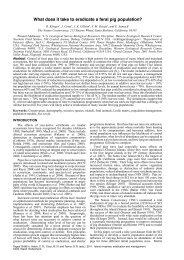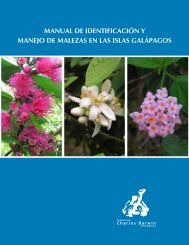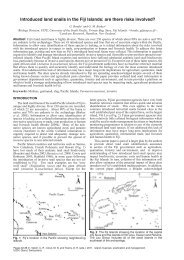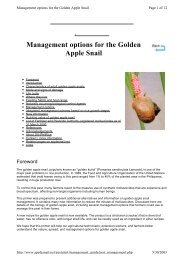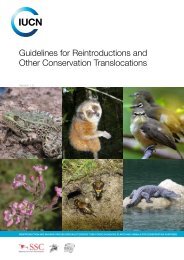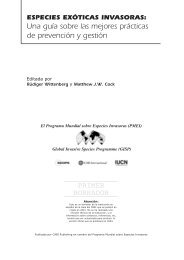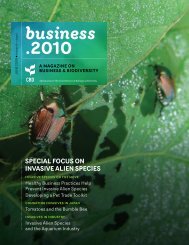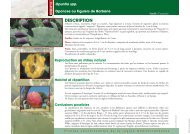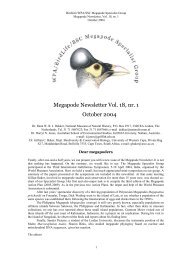Invasive alien fauna in Sri Lanka: National list, impacts and ...
Invasive alien fauna in Sri Lanka: National list, impacts and ...
Invasive alien fauna in Sri Lanka: National list, impacts and ...
Create successful ePaper yourself
Turn your PDF publications into a flip-book with our unique Google optimized e-Paper software.
Isl<strong>and</strong> <strong>in</strong>vasives: eradication <strong>and</strong> management<br />
Table 1 Distribution of <strong>in</strong>vasive <strong>alien</strong> <strong>fauna</strong> <strong>in</strong> the seven prov<strong>in</strong>ces of <strong>Sri</strong> <strong>Lanka</strong>* P = recorded as present (Adopted from:<br />
Silva <strong>and</strong> Kurukulasuriya 2010).<br />
<strong>Invasive</strong> Alien Fauna NW NC UP WP CP EP SP<br />
Clown knifefish (Chitala ornata) P P - P - - P<br />
Plecostomus catfish (Hypostomus plecostomus) P - - P - - -<br />
Walk<strong>in</strong>g catfish (Clarias batrachus) P - - P - - -<br />
Guppy (Poecilia reticulata) P - - P - - P<br />
Western mosquitofish (Gambusia aff<strong>in</strong>is) P - - P - - -<br />
Mosambique tilapia (Oreochromis mossambicus) P P P P P - P<br />
Carp (Cypr<strong>in</strong>us carpio) - - - P - P -<br />
Snakesk<strong>in</strong> gouramy (Trichogaster pectoralis)** - - - - - - -<br />
Red eared slider turtle (Trachemys scripta) - P - P - - -<br />
House mouse (Mus musculus) - - - P - - -<br />
Ship rat (Rattus rattus norvegicus) - - - P - - -<br />
Feral cat (Felis catus) - - - P - - -<br />
Feral dog (Canis familiaris) - - - P - - -<br />
Feral buffalo (Bubalus bubalis) P - P - - - P<br />
Apple snail (Pomacea diffusa) - - - P - - P<br />
Giant African snail (Lissachat<strong>in</strong>a fulica) - - - P - - -<br />
Field slug (Laevicaulis alte) - - - P - - -<br />
Ra<strong>in</strong>bow trout (Oncorhynchus mykiss)** - - - - - - -<br />
Garden slug (Deroceras reticulatum)** - - - - - - -<br />
Garden slug (Deroceras caruanae)** - - - - - - -<br />
*NW – North Western Prov<strong>in</strong>ce, NC – North Central Prov<strong>in</strong>ce, UP – Uva Prov<strong>in</strong>ce, WP – Western Prov<strong>in</strong>ce, CP – Central Prov<strong>in</strong>ce, EP –<br />
Eastern Prov<strong>in</strong>ce, SP – Southern Prov<strong>in</strong>ce.<br />
** These species have not been recorded <strong>in</strong> any of the above prov<strong>in</strong>ces despite been <strong>list</strong>ed <strong>in</strong> the previous national <strong>list</strong>s<br />
(Bambaradeniya 2000, 2002; Marambe et al. 2001; Wijesekera <strong>and</strong> Bambaradeniya 2007)<br />
of large mammal, <strong>and</strong> species of molluscs. In addition,<br />
16 species have been identified as <strong>alien</strong> <strong>fauna</strong> with a<br />
potential to become <strong>in</strong>vasive <strong>and</strong> eight species <strong>list</strong>ed by<br />
Bambaradeniya (2002) lack recent records (see Table 1).<br />
IMPACTS OF INVASIVE ALIEN FAUNA IN SRI<br />
LANKA<br />
Threats posed by IAS to native species <strong>in</strong>clude direct<br />
exploitation or destruction, competition for resources,<br />
hybridisation <strong>and</strong> the other <strong>impacts</strong>. The follow<strong>in</strong>g section<br />
illustrates with specific examples the likely <strong>impacts</strong> of IAS<br />
<strong>in</strong> <strong>Sri</strong> <strong>Lanka</strong>, under the above impact categories.<br />
Direct exploitation/destruction of native species<br />
The clown knifefish (Chitala ornata) is a large predator<br />
<strong>in</strong>troduced <strong>in</strong> 1994. Subsequently, there have been decreases<br />
<strong>in</strong> the abundance of native fish such as Aplochielus<br />
dayi, A. parvus, Horad<strong>and</strong>iya athukorali, P. vittatus,<br />
P. bimaculatus, R. daniconius <strong>and</strong> Amblypharyngodon<br />
melett<strong>in</strong>us (Gunawardena 2002). The predatory walk<strong>in</strong>g<br />
catfish (Clarias batrachus) also has direct effects on native<br />
species (Weerawardane <strong>and</strong> Dissanayake 2005).<br />
The guppy (Poecilia reticulata) was <strong>in</strong>troduced to<br />
control mosquito larvae based on its larvivorous feed<strong>in</strong>g<br />
habits, but its efficacy as a bio-control agent is now<br />
questionable. Research by Shirantha et al. (2008) showed<br />
that guppy feed<strong>in</strong>g habits have become more carnivorous<br />
<strong>and</strong> the species is now feed<strong>in</strong>g on the eggs of amphibians<br />
(Bambaradeniya 1999).<br />
Feral populations of cats (Felis catus) <strong>and</strong> dogs (Canis<br />
familiaris) prey on wild reptiles, birds <strong>and</strong> small mammals<br />
(www.sundaytimes.lk/030615/funday/2.html). Feral dogs<br />
have been seen attack<strong>in</strong>g wild animals <strong>in</strong> Bundala <strong>National</strong><br />
Park (Bambaradeniya et al. 2002) <strong>and</strong> the dogs also avidly<br />
search for <strong>and</strong> feed on the eggs of mar<strong>in</strong>e turtles <strong>in</strong> coastal<br />
areas (De Silva 1999, Ilangakone 2000, Bambaradeniya et<br />
al. 2002). De Silva (2007) has documented domestic cats<br />
destroy<strong>in</strong>g herpeto<strong>fauna</strong> <strong>in</strong> home gardens.<br />
Superior competitors for resources<br />
In <strong>Sri</strong> <strong>Lanka</strong>, Mosambique tilapia (Oreochromis<br />
mossambicus) is non-selective <strong>in</strong> its diet <strong>and</strong> breeds<br />
prolifically, enabl<strong>in</strong>g it to colonise tanks, reservoirs <strong>and</strong><br />
slow flow<strong>in</strong>g rivers while displac<strong>in</strong>g native <strong>in</strong>habitants<br />
such as Labeo porcellus <strong>and</strong> L. dussumieri (Pethiyagoda<br />
1999). The diet of small tilapia comprises zooplankton,<br />
which are food resources for <strong>in</strong>digenous fish. The endemic<br />
red-f<strong>in</strong> labeo (L. lankae) overlaps <strong>in</strong> distribution with<br />
tilapia <strong>and</strong> has been driven to near ext<strong>in</strong>ction, possibly due<br />
to this competition (Pethiyagoda 1999, 2006).<br />
Mozambique tilapia also occupies the same habitats<br />
as the <strong>in</strong>digenous cichlid Etroplus suratensis, <strong>and</strong> the two<br />
species probably compete for nest<strong>in</strong>g space (Ahamed <strong>and</strong><br />
Dharmaretnam 2008). The <strong>list</strong><strong>in</strong>g of Mozambique tilapia<br />
as an IAS was challenged by aquaculture specia<strong>list</strong>s who<br />
claimed that endemic fish species do not exist <strong>in</strong> the<br />
reservoirs where tilapias are abundant (Amaras<strong>in</strong>ghe et al.<br />
2006). Populations of Mozambique tilapia that established <strong>in</strong><br />
some non-flow<strong>in</strong>g habitats showed little significant dietary<br />
overlap with <strong>in</strong>digenous fish species (Amaras<strong>in</strong>ghe et al.<br />
2008). These contradictory views <strong>in</strong>dicate that the impact<br />
of co-occurr<strong>in</strong>g populations of tilapia <strong>and</strong> <strong>in</strong>digenous fish<br />
is not clear <strong>and</strong> further assessment is warranted.<br />
The tank cleaner (Hypostomus plecostomus) can<br />
out-compete native biota. The species is an omnivore<br />
with a diet vary<strong>in</strong>g from plankton to plant matter <strong>and</strong><br />
<strong>in</strong>vertebrates. Further <strong>in</strong>vasion to <strong>in</strong>l<strong>and</strong> waters may pose<br />
a threat to endemic fish species (Wijethunga <strong>and</strong> Epa<br />
2008). The scrape feed<strong>in</strong>g habits of the tank cleaner could<br />
change habitat quality, lead<strong>in</strong>g to detrimental effects on cooccurr<strong>in</strong>g<br />
species (Amaras<strong>in</strong>ghe et al. 2006).<br />
In the dry zone, feral buffaloes (Bubalus bubalis)<br />
compete for food with herbivores such as deer (Rusa<br />
alfredi), sambur (R. unicolor) <strong>and</strong> elephants (Elephas<br />
maximus). Their wallow<strong>in</strong>g muddies aquatic habitats,<br />
which deters their use by other animals such as elephants<br />
(Bambaradeniya 2000). In S<strong>in</strong>haraja ra<strong>in</strong>forest, exotic<br />
446



